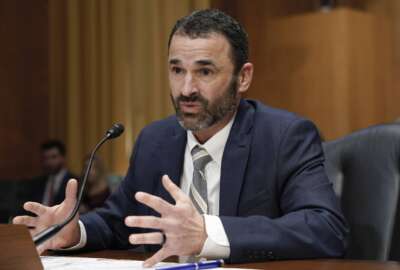The No Labels Caucus will introduce a bill this week to apply more pressure on agencies to use strategic sourcing.
The bill is one of nine that the caucus of Democrats and Republicans is scheduled to release, in an effort to make the government more efficient and effective.
The No Labels Caucus, which calls itself a problem-solver rising above the partisan fray, will hold a press conference Thursday in Washington to unveil the assorted legislative proposals.
The strategic sourcing legislation is starting to gain support. At the Senate Homeland Security and Government Affairs Committee’s hearing Monday, Cristina Chaplain, the Government Accountability Office’s director of acquisition and sourcing management, said there are several things Congress could do to encourage agencies to buy more efficiently. Her suggestions mirror the No Labels bill in many ways. Chaplain said oversight and hearings may apply the most direct pressure, but legislation could have its role too.
“There could be legislation that actually requires the government to set governmentwide goals for strategic sourcing. There are none right now,” Chaplain said Monday at the hearing. “The goals could be tailored by agencies as well. There also could be goals separated not just in terms of how much we should strategically source, but what savings we hope to get. From there, you could break things down in terms of what should be done at the agency levels. Should they have accountable officials? What should their responsibilities be? That’s something you can ask the executive agencies to do.”
Draft bill sets goals
An early draft of the legislation obtained by Federal News Radio would require President Barack Obama to establish a goal of saving no less than $10 billion a year based on $100 billion of federal spending in 2014 and 2015. In the out years, the bill sets a goal of saving no less than $7.5 billion based on $150 billion in spending in 2016 and 2017.
The bill calls on each agency to establish a specific goal for savings that would equal the governmentwide target. Additionally, the proposal calls for guidance from the Office of Management and Budget to address data collection, savings metrics and criteria, and procedures to hold agencies accountable for meeting the goals.
Sources say that after receiving comments from other lawmakers and industries, the No Labels Caucus changed the bill that will be introduced this week. The updated version of the bill better defines the strategic sourcing principles agencies should follow, including giving more attention to small businesses — a major concern of industry. The bill also changes the goals and gives OMB more oversight into the implementation.
The bill and recent hearings stem from two recent GAO reports that found agencies are leaving billions of dollars in savings on the table. Four of the largest agencies (the departments of Defense, Energy, Homeland Security and Veterans Affairs), accounting for 80 percent of the federal procurement spend, used strategic sourcing for only about 5 percent, or $25.8 billion, of their total spend. GAO found the industry average is 4 percent to 15 percent.
When asked about the No Labels bill, a spokesperson for the committee said by email, “Chairman [Tom] Carper (D-Del.) believes that the government can do much better to promote strategic sourcing and save taxpayers money in the long run, as he expressed during today’s hearing. Moving forward, he will continue to work with his Senate and House colleagues and the administration to find a solution to improve on the efficiency of government purchasing, and ensure the taxpayers are getting the best services for their dollars.”
Little success over the years
Senators highlighted the lack of progress by the government to save money and buy smarter as compared to Fortune 500 companies. Sen. Ron Johnson (R-Wis.) said agencies have been trying to get their arms around strategic sourcing since the 1980s with little to no success.
“It’s about information, it’s about data and it’s about accountability. But let me throw another word out there — incentives. Why does business do it? Because business has to make a profit. Every business manager undergoing strategic purchasing doesn’t necessarily have that profit motive, but they are being driven by the profit motive because their manager is telling them their budget has been cut by 10 percent,” he said. “So that’d be the question I have for you. How can we instill an incentive into the government bureaucracy to actually start accomplishing some of this stuff, which truthfully should have been accomplished and implemented decades ago?”
Joe Jordan, the administrator of the Office of Federal Procurement Policy, said incentives are tough in the government. Without a profit motive, the administration has to figure out another way to move agencies in the right direction. Jordan said he thinks the prices paid portal will help. This allows contracting officers to see how much others are paying for similar products or services.
Chaplain said too often the appropriations process discourages agencies from using strategic sourcing. If agencies do claim savings, their budget gets reduced, and they fear losing control over spending. Chaplain said the government has to use positive incentives rather than negative ones. DHS is using positive incentives to promote strategic sourcing. She said DHS is putting requirements in senior officials’ performance plans.
“They are an agency that is ahead of others. They have about 20 percent of their procurement spending going through strategic sourcing,” Chaplain said. “Leading companies, likewise, put incentives into executive contracts. That’s the best way to get people to behave and overcome these perceptions.”
Tied to performance goals
At the General Services Administration, senior executives’ performance plans are starting to include small business and strategic sourcing goals.
Dan Tangherlini, the administrator of GSA, said the focus isn’t on bonuses but the basic performance expectations of senior executives.
“I want the executives to know and they want to know what is the expectation, what is it you are trying to get done?” he said. “I think by having a clear set of expectations for performance management for senior executives in the federal government, I’ve seen senior executives do truly amazing things. What we need to do is recognize our responsibility as leaders and managers to make clear for those leaders and managers what we are expecting them to deliver.”
Sen. Claire McCaskill (D-Mo.) said tying strategic sourcing to senior executive bonuses and pay is not the right incentive. She said over the years agencies have not used performance plans to hold SESers accountable because too many officials receive bonuses automatically. McCaskill said there are too many disincentives in government to use strategic sourcing.
“Until we have the right incentives in place, we’re not gonna really ever do anything but have…a lot of councils, a lot of hemming and hawing about guidance. It’s still a lot of saying ‘hey, there’s a new sheriff in town, and you are going to strategically source what you’re buying.’ That’s what we need to be saying on this stuff,” she said.
While legislation works its way through the process, Sen. Tom Coburn (R-Okla.), ranking member of the committee, said he’d like to see OFPP release guidance for how agencies should measure savings.
Jordan didn’t offer any insight into what OFPP’s plans are around new guidance. He said the administration established savings goals through the Cross-Agency Priority (CAP) goals. Agencies must strategically source two commodities, including at least one that involves technology, and show at least 10 percent savings. Jordan said the deadline hasn’t passed yet for agencies to have met those goals.
RELATED STORIES:
” target=”_blank”>Agencies ignoring billions in savings from strategic sourcing





